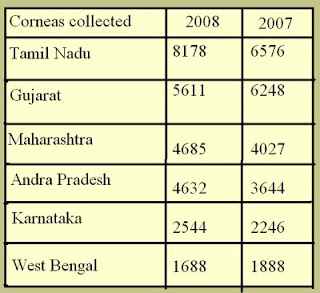Here are somethings I discovered and these I am sharing with you.
1)What is eye donation?
Eye donation essentially means recovering the cornea, the transparent cover on the pupil. This part is transplanted on the recipient to improve / restore vision. Donation from one person gets two corneas, that are used separately on two persons.
2) Who can benefit?
Cornea transplant is necessary when the cornea gets damaged due to prolonged illness, neglect and poor treatment. Doctors said that poor patients from rural areas form the biggest chunk of cornea recipients because often they approach a doctor when the damage is already done. Some patients born with congenital cornea defects can also benefit from eye donations.
In some cases, a cornea transplant is also used as therapeutic grafting to aid in healing of damaged tissue.
Contrary to my notion, eye donations thus do not cure all kinds of blindness, but only corneal blindness.
3) Initiatives:
Under the Hospital Cornea Retrieval Programme (HCRP), grief counsellors are appointed at hospitals where about 6-7 deaths occur daily. These counsellors approach the bereaved family and suggest eye donation. Donations have drastically gone up at places where HCRP has been implemented.
As of now, grief counsellors, appointed by NGOs, are paid paltry amounts. Under the 11th five-year plan, government has come up with grants for grief counsellors.
Whose eyes cannot be used for transplant:
Eyes of a person who has died of slow virus diseases like AIDS; Mad cow disease, Rabies, Hepatitis, Encephalitis, Septicemia, Snake bite, Tetanus, Luekaemia, or had certain eye infections, iritis (inflammation of anterior segment of eye), low corneal endothelial counts cannot be used for corneal transplant.
Statistics:
About 1.1 million people suffer from corneal blindness in India and families of only about 15000 people consented for eye donation in 2008.

Source: Eye Bank Association of India
Points to remember:
Eye must be removed within six hours of death
Gently suggest eye donation to a calm person of the bereaved family, if possible after 30 minutes of 'grief window'. By this time, the family has actually accepted the death
Contact the nearest eye collection centre immediately
The removal takes 10-15 minutes and is free
It can be done at home or any other place where the body is kept
It does not disfigure the face
Eye donation by a single person helps restore sight of two corneal blind people
Religious leaders throughout the world have voiced their support
Source: Doctors, National Program for Control of Blindness website
Related posts:
Eye donation follow-up 1
Hope amidst grief
The End of an Era